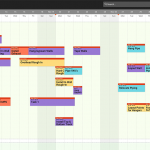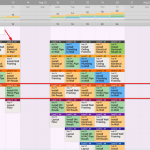(By Hal Macomber, EVP Touchplan and George Hunt, Lead – Pre-Sales/Sales Engineering Touchplan) Variation is present in things we do every day. From variation in driving speeds on the highway leading to traffic jams, to the varying weather conditions causing us to delay our planned concrete placement, variation has a huge impact on our daily lives. More specific to our projects, unmanaged variation leads to delays, blown estimates, unsafe conditions, and loads of frustration. Understanding why variation is such a big deal, how it affects our projects, and how we can counteract it, can ultimately lead to more positive project outcomes.
We learned three key lessons about project production management (PPM) from Toyota that directly relates to our work in design and construction.
- Ensure that the production process is not overburdened. Don’t carry a load more than you can handle; don’t run a process longer than the design parameters; don’t cram work into a time shorter than is needed. That’s overburdening.
- Variation must be observed and managed otherwise it compounds. Tolerances stack; early and late completions don’t offset each other; and variation compounds with dependence.
- Identify and remove waste in our processes. This requires understanding what adds “value” in a process. Everything else is waste from the customer’s perspective.
The order of these lessons matter. While we didn’t know that when we learned these lessons, we do now. Many companies who were serious about Lean attacked waste first. Why? Reducing waste meant decreased costs and reduced time through production. Unfortunately, working on waste before taking care of the first two items isn’t sustainable.
First, a few words about overburdening: DON’T DO IT.
It’s dangerous for a 10-ton crane to attempt to lift 15 tons. Don’t do it. It’s dangerous for people to work in the hot sun without adequate hydration. Don’t do it. People working long hours on a regular basis cause undetected errors. Don’t do it. Make sure that people, processes and equipment are right-sized for the work that needs to be done.
What’s the big deal about variation?
We’ll start with our commonsense. Which of the following actions are good for your project?
|
|
Our commonsense or common practice often produces exactly the opposite of what we want. For instance, on critical path-managed projects, teams focus on starting every activity as planned. This practice often leads to excess work in process and therefore a late project. (We’ll cover this in detail in an upcoming post.) The right-side options from the above list produce better outcomes. We have to change our commonsense to get the most from PPM.
Those of you who have played the Lean Construction Institute’s Parade of Trades® simulation have experienced operations that are dependent on the output of prior ones; any gains in the upstream operations are lost. In addition, those losses accumulate for downstream operations on an exponential basis! The larger the variation the more variation compounds. Try a thought experiment with me.
We have a simple three operation sequence of work. Each crew works at the same average pace of six units per day. It will take them five days on average each to complete their work for the 30 units. Each operation starts one day after the preceding operation.
Day one: 1st operation does 5 units
Day two: 2nd operation does 4 units and 1st operation does 7 units
Day three; 3rd operation does 4 units; 2nd operation does 5 units; 1st operation does 5 units.
This pattern continues for an expected nine days. All crews are prepared to do all of their 6 units, however except for the 1st operation, the other operations can’t do more than the work that is ready for them regardless of how efficient the crews are. Upstream gains are lost and losses accumulate. We can predict that work will not finish by day nine, and we don’t know when it will finish. How would this work out in a 25 operation sequence of work for 100 units? … Yes, it’s unpredictable. Most of the time, it’s so unpredictable that we routinely buffer our estimates for how long the project will take.
What can we do to counteract variation?
We have a number of countermeasures or practices available to minimize variation and the effect on our performance.
- Make the work ready for the people and the people ready for the work. This entails a rigorous evaluation of any roadblock or hurdle that could keep work from starting and finishing. We call these constraints. The purpose of look-ahead planning is to surface and resolve constraints so there is no impediment to doing the work that we agreed we should be doing.
- A great way to counteract variation in the rate of performing work is to establish a fixed pace. Lean Construction adopted the german word for this — takt. Set a pace that every operation in a sequence will work. Establish swing capacity (buffer) so that work can usually/always be done as planned. Maintain available alternative work (workable backlog) for that swing capacity so they are always productive.
- Use interim milestones so the collection of crews can see that they are “making the pace” (progress principle).
- Every week make reliable promises from one trade to the others that are based on having the capacity and material to do the work they promise.
- Learn from the variation that you experience. Status the work daily including the reasons for variation. Use five whys to understand the underlying cause(s) of the variation. Take countermeasures to improve it.
Reducing variation on your project is one of the best ways to get the outcomes you want. It’s not as difficult as you may think. It starts by making a shift in common practice/commonsense coupled with the above five practices. Skeptical? Try it!
For more information on the best ways to reduce variation read how Data-Driven Planning Delivers Projects Faster. If you missed last week’s post, please read Flow Provides Focus for Production Project Management.









